| Ol Doinyo Lengai (Oldoinyo Lengai) | |
|---|---|
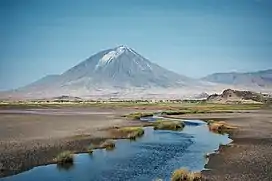 | |
| Highest point | |
| Elevation | 2,962 m (9,718 ft)[1] |
| Prominence | 1,360 m (4,460 ft) |
| Isolation | 16.68 km (10.36 mi) |
| Coordinates | 2°45′50″S 35°54′50″E / 2.764°S 35.914°E[1] |
| Geography | |
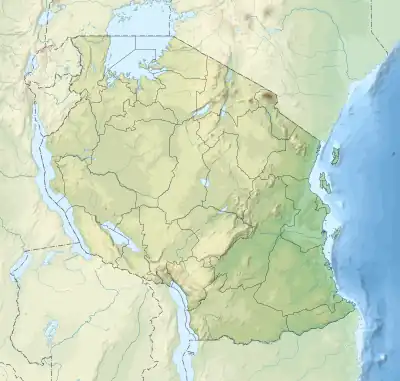 Ol Doinyo Lengai (Oldoinyo Lengai) | |
| Parent range | East African Rift |
| Geology | |
| Mountain type | Stratovolcano |
| Last eruption | 2023 AD |
Ol Doinyo Lengai is an active volcano in Tanzania. It consists of a volcanic cone with two craters, the northern of which has erupted during historical time. Uniquely for volcanoes on Earth, it has erupted natrocarbonatite, an unusual, cold and highly fluid type of magma. Recent eruptions in 2007-2008 impacted the surrounding region.
Name
The Maasai and Sonjo people refer to the volcano as "The Mountain of God", viewing it as the abode of the god Engai, who withdrew there after being hit by a hunter with an arrow.[2] Other names are Basanjo, Donjo Ngai, Duenjo Ngai, Mongogogura, Mungogo wa Bogwe and Oldonyo L'Engai.[3]
Geography and geomorphology
Ol Doinyo Lengai lies in Tanzania,[4] 16 kilometres (9.9 mi) south of Lake Natron[5] and 120 kilometres (75 mi) northwest of Arusha.[6] The summit was first explored between 1904 and 1915.[7] As of 2012 about 300,000 people live in the region, and livestock farming is the most important economic activity although tourism is increasingly important.[8]
Ol Doinyo Lengai is a symmetric cone[1] that rises more than 1,800 metres (5,900 ft) above the surrounding rift valley.[9] It has two craters on either side of the mountain summit,[10] which is formed by a 110 metres (360 ft) high ridge.[11] The floor of the northern crater is covered with lava flows that resemble pahoehoe lavas. Small cones[lower-alpha 1] with sizes ranging from 2 metres (6 ft 7 in) to over 10 metres (33 ft) occur in the crater and produce lava flows from their summits and, when they collapse, from their flanks.[4] The southern crater is inactive and sometimes filled with water.[13] White volcanic ash deposits cover the slopes of the volcano,[10] which have large fractures on the western flank.[8] There are parasitic vents on Ol Doinyo Lengai's flanks,[14] such as Kirurum Crater on the western, the Nasira cones on the northern, Dorobo crater on the northeastern and Oltatwa Crater on the eastern flank.[15]
There are deposits of past debris avalanches around the volcano, especially on its northern flank;[16] one such event has left a scar on the volcano's flanks.[17] Their occurrence may have been influenced by regional fault systems.[18]
Geology
Ol Doinyo Lengai is part of the Gregory Rift,[1] which is part of the active East African Rift. The East African Rift is a continental rift extending from eastern to southern Africa over a length of 4,000 kilometres (2,500 mi),[19] where there is high heat flow through a thinned crust.[20] In the Gregory Rift, spreading began about 1.2 million years ago[19] and is ongoing at a rate of about 3 millimetres per year (0.12 in/year).[21] The Natron Fault, the western boundary of the Gregory Rift in the area, passes just southwest of the volcano.[22]
The volcano is part of the Ngorongoro volcanic highland, a system of volcanoes that were active from the Miocene to present, and which includes the Ngorongoro and other volcanoes.[19] Over time, volcanic activity shifted northeastward to the present-day Ol Doinyo Lengai.[23] Other volcanoes in the area are Gelai northeast[lower-alpha 2] and Ketumbeine southeast of Ol Doinyo Lengai; farther away are the Olduvai Gorge west and Kilimanjaro mountain east of the volcano.[9]
Composition
Most of the volcanic cone is formed by melilite, nephelinite and phonolite.[lower-alpha 3][25] Ol Doinyo Lengai is the only volcano on Earth known to have erupted carbonatitic lavas[lower-alpha 4] during historical times,[1] although these rocks make up only a small fraction of the volcano[14] and only occur in the northern crater;[lower-alpha 5][26] they only recently appeared on the volcano.[12] The properties of Ol Doinyo Lengai's magmas have been used as an analogue for the conditions on carbon planets; these are planets which are rich in carbon.[20]
Chemical composition:
- The carbonatites contain a groundmass of fluorite and sylvite, while apatite, galena, magnetite, monticellite, sellaite and sphalerite form accessory components.[14]
- The silicic lavas contain combeite, ijolites, melanite, nepheline, phlogopite and pyroxene, as well as apatite, garnet, sphene and wollastonite.[27]
- Xenoliths from the basement have been found and consist of gneiss and other metamorphic rocks,[28] as well as ijolites, pyroxenites and urtites.[11]
The carbonatite lavas are rapidly chemically modified by rainfall[29] or covered by deposits condensing from fumarolic gases,[30] yielding secondary minerals like calcite, gaylussite, nahcolite, pirssonite, shortite, thermonatrite and trona,[31] including various chlorides, fluorides[lower-alpha 6] and sulfates.[4] These rocks form crusts on the lava flows and within lava tubes.[12] Weathering on the silicic rocks has yielded zeoliths.[33]
The chemical composition of the erupted rocks is not steady, with an increase of silicic magma emplacement noted after 2007-2008, after an episode of increased spreading in the Gregory Rift.[34] The carbonatitic magmas appear to form through the separation of carbon-rich phases; the original magma is variously interpreted to be either nephelinitic or silicic.[20] The phonolites appear to have a separate origin from the other volcanic rocks.[35] There appear to be two magma reservoirs under the volcano,[36] and its plumbing system is complex, involving regional tectonic structures.[37]
Volcanic gases
Volcanic gas sampled at Ol Doinyo Lengai consists mostly of water and carbon dioxide and originates in the mantle.[38] The volcano is a major source of volcanic carbon dioxide, producing about 80 kilograms per second (11,000 lb/min) of CO
2.[25]
Eruption history
The volcano began erupting between >500,000[14] to 22,000 years ago.[39] It formed in two stages, a Lengai I consisting of phonolite that forms about 60% of the volume of Ol Doinyo Lengai and crops out in its southern part, and a Lengai II formed by nephelinitic rocks;[14][40][11] growth of the volcanic cone was complete about 15,000 years ago,[1] when the Naisiusiu Beds were emplaced in the Olduvai Gorge.[41] The volcano collapsed several times, including once between 850,000 and 135,000 years ago and another time between 50,000 and 10,000 years ago.[16] The oldest natrocarbonatite lavas date to 1,250 years before present.[38] An eruption 3,000-2,500 years before present produced a tephra fallout west of Ol Doinyo Lengai, that is presently being eroded by wind and forming dunes including the Shifting Sands of the Olduvai Gorge.[42] A large eruption deposited the Namorod Ash in the gorge, about 1,250 years ago,[33] and another about 600 years ago formed the so-called "Footprint Tuff".[33] Ol Doinyo Lengai is the only presently active volcano of the Gregory Rift.[9]
Records of eruptions go back to the 1880s.[43][lower-alpha 7] The volcano is continually active, but there are seldom observations of its activity.[45] It erupts tephra and lava flows[10] from within the northern crater.[9] During the middle 20th century the crater was about 200 metres (660 ft) deep; subsequently, lava flows filled it and by 1998 lava was overflowing its rims.[1] The lava flows issue from cones within the crater and form lava ponds and lakes.[6] Explosive eruptions are less common, having been reported in 1917, 1940, 1966,[lower-alpha 8] 1983 and 1993.[38][46] Oversteepened slopes produce landslides[10] and erosion has cut gullies into volcanic deposits.[47] Steam jets have also been observed.[44]
There is evidence of underground magma intrusions.[21] Satellite observations have shown deformation of the volcano during eruptions,[48] and ground-based observations have identified movement in neighbouring fault systems such as the Natron Fault caused by magma originating at Ol Doinyo Lengai.[49]
Recent eruptive period: 1983 and subsequent
After a phase of quiescence,[25] renewed activity commenced in 1983 and continues[10] with several interruptions to this day.[50] During the 1983 eruption, ashfall occurred at tens of kilometres from the volcano.[25] The emission of a lava flow onto the western flank of Ol Doinyo Lengai in 2006 was accompanied by the formation of a pit crater on the summit.[51]
A large explosive eruption began on the 4 September 2007, producing a 3 kilometres (1.9 mi) high eruption column[52] a new, 100 metres (330 ft) deep and 300 metres (980 ft) wide crater.[53] The explosive activity continued into 2008, when the volcano settled back into the effusion of lava flows;[52] a cinder cone formed in the northern crater during the eruption.[54] Aerosol clouds from the eruption[55] extended over east Africa.[56] The 2007 eruptions forced the evacuation of three villages[57] and disturbed air travel in the touristically important area;[58] livestock fatalities and injuries to people led to requests that the government of Tansania enact access restrictions to the volcano[59] and to increased awareness of the threat formed by the volcano.[60] Wild animals such as flamingos were also impacted by the eruption.[58] The eruption was preceded in July by seismic activity, which was frequently mistaken for renewed eruptions,[61] and the intrusion of a dyke less than 20 kilometres (12 mi) from Ol Doinyo Lengai.[37]
General appearance of lava flows
Lavas erupted by Ol Doinyo Lengai initially have brown or black colours, but within days[44] to hours become white like snow.[10] The lavas of Ol Doinyo Lengai have temperatures of 540–593 °C (1,004–1,099 °F);[4] they are so cold that during the day they look like mudflows[lower-alpha 9] or oil and glow only during the night.[6] They are highly fluid (reaching flow speeds of 1–5 metres per second (3.3–16.4 ft/s),[4] making them the most liquid known magmas[12]) and form short (few tens of metres) and thin (few centimetres thick) lava flows.[10] More viscous flows containing silicic rocks have also been observed, for example during the 1993 eruption.[63]
Hazards
Potential threats from Ol Doinyo Lengai eruptions are scarcely established.[64] Threats from eruptions at Ol Doinyo Lengai include lahars, landslides, lava flows, pyroclastic flows, volcanic bombs, volcanic gas and volcanic ash fall.[65][8] Beginning in 2016, the volcano is being monitored by a seismometer and GNSS stations.[65]
Climate and vegetation
Vegetation in the area consists mostly of grassland, which reaches an elevation of 1,750 metres (5,740 ft) above sea level.[8] Volcanic ash from Ol Doinyo Lengai influences the surrounding landscape, favouring the growth of nutrient-rich plants.[66] Precipitation falls during two wet seasons in March–May and October–December.[8]
Gallery
 Ol Doinyo Lengai erupting in March 2008.
Ol Doinyo Lengai erupting in March 2008. Ol Doinyo Lengai after an explosive eruption.
Ol Doinyo Lengai after an explosive eruption.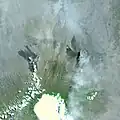 Image of the volcano sending a plume of ash and steam southward.
Image of the volcano sending a plume of ash and steam southward. Aerial photo of Oldoinyo Lengai in 2011.
Aerial photo of Oldoinyo Lengai in 2011.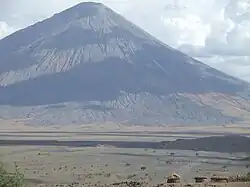 Ol Doinyo Lengai in October 2011.
Ol Doinyo Lengai in October 2011.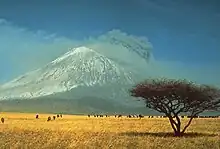 Image of 1966 eruption
Image of 1966 eruption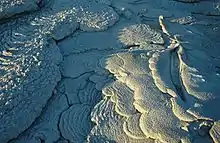 Solidified lava in the crater of Ol Doinyo Lengai.
Solidified lava in the crater of Ol Doinyo Lengai..jpg.webp) Crater of Ol Doinyo Lengai in January 2011.
Crater of Ol Doinyo Lengai in January 2011.
See also
Notes
- ↑ Known as hornitos.[12]
- ↑ The Naibor Soito monogenetic volcanic field lies between Gelai and Ol Doinyo Lengai.[24]
- ↑ Together they make up more than 90% of the cone.[12]
- ↑ Carbonatites are magmas that consist of carbonate compounds.[9] At Ol Doinyo Lengai, they are made up of nyererite (Na
2Ca(CO
3)
2) and gregoryite ((Na
,K
,Ca)
2CO
3).[4] - ↑ Silicic lavas mostly issued from the southern crater.[12]
- ↑ The volcanic rocks contain up to several percent chlorine and fluorine by weight.[32]
- ↑ Eruptions have been recorded in 1880, 1894 (?), 1904, 1913-15, 1917, 1921, 1926, 1940-41, 1954-55, 1958, and 1960.[44]
- ↑ 1966 saw explosive eruptions in August and October, which formed a deep crater.[10]
- ↑ And have been confused for mud by non-volcanologists.[62]
References
- 1 2 3 4 5 6 7 GVP 2023, General Information.
- ↑ Bernbaum 2022, p. 183.
- ↑ GVP 2023, Synonyms & Subfeatures.
- 1 2 3 4 5 6 McFarlane, Lundberg & Belton 2004, p. 98.
- ↑ Mangler et al. 2014, p. 43.
- 1 2 3 Muthama, Mathu & Kamau 2012, p. 8.
- ↑ Zaitsev, Keller & Billström 2009, p. 303.
- 1 2 3 4 5 Rey et al. 2021, p. 72.
- 1 2 3 4 5 Nyamweru 1988, p. 603.
- 1 2 3 4 5 6 7 8 GVP 2023, Photo Gallery.
- 1 2 3 Sekisova et al. 2015, p. 1719.
- 1 2 3 4 5 6 Gilbert & Williams-Jones 2008, p. 520.
- ↑ Kervyn et al. 2010, p. 921.
- 1 2 3 4 5 Mangler et al. 2014, p. 44.
- ↑ Klaudius & Keller 2006, p. 174.
- 1 2 Delcamp et al. 2015, p. 7.
- ↑ Delcamp et al. 2015, p. 8.
- ↑ Delcamp et al. 2015, p. 17.
- 1 2 3 Mollel & Swisher 2012, p. 274.
- 1 2 3 Radebaugh, Barnes & Keith 2020, p. 1.
- 1 2 Jones et al. 2019, p. 2517.
- ↑ Jones et al. 2019, p. 2522.
- ↑ Mollel & Swisher 2012, p. 276.
- ↑ Ho & Wauthier 2022.
- 1 2 3 4 Oppenheimer 1998, p. 55.
- ↑ Klaudius & Keller 2006, p. 173.
- ↑ Oppenheimer 1998, p. 60.
- ↑ Morogan & Martin 1985, p. 1114.
- ↑ Robertson et al. 2014.
- ↑ Gilbert & Williams-Jones 2008, p. 524.
- ↑ Zaitsev, Keller & Billström 2009, p. 302.
- ↑ Mangler et al. 2014, p. 51.
- 1 2 3 Hay 1989, p. 80.
- ↑ Jones et al. 2019, p. 2518.
- ↑ Mangler et al. 2014, p. 48.
- ↑ Daud Masungulwa et al. 2021.
- 1 2 Biggs et al. 2021, p. 3.
- 1 2 3 Fischer et al. 2006.
- ↑ Mollel & Swisher 2012, p. 278.
- ↑ Klaudius & Keller 2006, p. 176.
- ↑ Hay 1989, p. 78.
- ↑ Makongoro et al. 2022, p. 209.
- ↑ Meshili & Kwon 2020, p. 401.
- 1 2 3 Nyamweru 1988, p. 604.
- ↑ Nyamweru 1990, p. 389.
- ↑ Kervyn et al. 2010, p. 926.
- ↑ Nyamweru 1990, p. 387.
- ↑ GVP 2023, Deformation history.
- ↑ Jones et al. 2019, p. 2525.
- ↑ GVP 2023, Eruption history.
- ↑ Kervyn et al. 2010, p. 915.
- 1 2 Kervyn et al. 2010, p. 914.
- ↑ Laxton 2020, p. 438.
- ↑ Kervyn et al. 2010, p. 924.
- ↑ Muthama, Mathu & Kamau 2012, p. 9.
- ↑ Muthama, Mathu & Kamau 2012, p. 15.
- ↑ Vye-Brown et al. 2014, p. 4.
- 1 2 Vye-Brown et al. 2014, p. 25.
- ↑ Vye-Brown et al. 2014, p. 2.
- ↑ Biggs et al. 2021, p. 9.
- ↑ Kervyn et al. 2010, p. 916.
- ↑ Nyamweru 1988, p. 610.
- ↑ Dawson et al. 1994, p. 799.
- ↑ Rey et al. 2021, p. 79.
- 1 2 Dye et al. 2022, p. 30.
- ↑ Morrison & Bolger 2014, p. 619.
Sources
- Bernbaum, Edwin (10 March 2022). Sacred Mountains of the World (2 ed.). Cambridge University Press. doi:10.1017/9781108873307.010. ISBN 978-1-108-87330-7.
- Biggs, Juliet; Ayele, Atalay; Fischer, Tobias P.; Fontijn, Karen; Hutchison, William; Kazimoto, Emmanuel; Whaler, Kathy; Wright, Tim J. (25 November 2021). "Volcanic activity and hazard in the East African Rift Zone". Nature Communications. 12 (1): 6881. Bibcode:2021NatCo..12.6881B. doi:10.1038/s41467-021-27166-y. ISSN 2041-1723. PMC 8616933. PMID 34824232.
- Daud Masungulwa, Ntambila Simon; Stamps, D. Sarah; Battaglia, Maurizio; Huang, Mong-Han; Saria, Elifuraha; Ji, Kang Hyeun; Popolizio, Kelsey (1 December 2021). Elucidating the Magma Plumbing System of the Active Volcano Ol Doinyo Lengai, Natron Rift, Tanzania Using Geodesy and Numerical Modeling. AGU Fall Meeting 2021. Vol. 2021. pp. G24B–05. Bibcode:2021AGUFM.G24B..05D.
- Dawson, J. B.; Pinkerton, H.; Pyle, D. M.; Nyamweru, C. (1994). "June 1993 eruption of Oldoinyo Lengai, Tanzania: exceptionally viscous and large carbonatite lava flows and evidence for coexisting silicate and carbonate magmas". Geology. 22 (9): 799–802. Bibcode:1994Geo....22..799D. doi:10.1130/0091-7613(1994)022<0799:JEOOLT>2.3.CO;2.
- Delcamp, A.; Delvaux, D.; Kwelwa, S.; Macheyeki, A.; Kervyn, M. (30 June 2015). "Sector collapse events at volcanoes in the North Tanzanian divergence zone and their implications for regional tectonics". Geological Society of America Bulletin: B31119.1. doi:10.1130/B31119.1. ISSN 0016-7606 – via ResearchGate.
- Dye, Mike; Stamps, D. Sarah; Mason, Myles; Saria, Elifuraha (1 March 2022). "Toward Autonomous Detection of Anomalous GNSS Data Via Applied Unsupervised Artificial Intelligence". International Journal of Semantic Computing. 16 (1): 29–45. doi:10.1142/S1793351X22400025. ISSN 1793-351X.
- Fischer, T.; Burnard, P.; Marty, B.; Palhol, F.; Mangasini, F.; Shaw, A. M. (1 December 2006). The 2005 and 2006 eruptions of Ol Doinyo Lengai: assessing deep and shallow processes at an active carbonatite volcano using volatile chemistry and fluxes. American Geophysical Union, Fall Meeting 2006. Vol. 2006. pp. V14B–04. Bibcode:2006AGUFM.V14B..04F.
- Gilbert, C.D.; Williams-Jones, A.E. (October 2008). "Vapour transport of rare earth elements (REE) in volcanic gas: Evidence from encrustations at Oldoinyo Lengai". Journal of Volcanology and Geothermal Research. 176 (4): 519–528. Bibcode:2008JVGR..176..519G. doi:10.1016/j.jvolgeores.2008.05.003.
- "Ol Doinyo Lengai". Global Volcanism Program. Smithsonian Institution. Retrieved 14 March 2023.
- Hay, Richard L. (1 March 1989). "Holocene carbonatite-nephelinite tephra deposits of Oldoinyo Lengai, Tanzania". Journal of Volcanology and Geothermal Research. 37 (1): 77–91. Bibcode:1989JVGR...37...77H. doi:10.1016/0377-0273(89)90114-5. ISSN 0377-0273.
- Ho, C.; Wauthier, C. (December 2022). Magmatic Processes in the Naibor Soito Distributed Volcanic Field, Tanzania Constrained from Satellite Geodesy and Seismicity. AGU Fall Meeting 2022.
- Jones, J. Robert; Stamps, D. Sarah; Wauthier, Christelle; Saria, Elifuraha; Biggs, Juliet (May 2019). "Evidence for Slip on a Border Fault Triggered by Magmatic Processes in an Immature Continental Rift". Geochemistry, Geophysics, Geosystems. 20 (5): 2515–2530. Bibcode:2019GGG....20.2515J. doi:10.1029/2018GC008165. ISSN 1525-2027. S2CID 135138771.
- Kervyn, Matthieu; Ernst, Gerald G. J.; Keller, Jörg; Vaughan, R. Greg; Klaudius, Jurgis; Pradal, Evelyne; Belton, Frederic; Mattsson, Hannes B.; Mbede, Evelyne; Jacobs, Patric (1 October 2010). "Fundamental changes in the activity of the natrocarbonatite volcano Oldoinyo Lengai, Tanzania". Bulletin of Volcanology. 72 (8): 913–931. doi:10.1007/s00445-010-0360-0. ISSN 1432-0819. S2CID 128562764.
- Klaudius, J; Keller, J (October 2006). "Peralkaline silicate lavas at Oldoinyo Lengai, Tanzania". Lithos. 91 (1–4): 173–190. Bibcode:2006Litho..91..173K. doi:10.1016/j.lithos.2006.03.017.
- Laxton, Kate (September 2020). "Collection of lava samples from Ol Doinyo Lengai". Nature Reviews Earth & Environment. 1 (9): 438. Bibcode:2020NRvEE...1..438L. doi:10.1038/s43017-020-0089-z. ISSN 2662-138X. S2CID 220856786.
- Makongoro, Mohamed Zengo; Vegi, Maheswara Rao; Vuai, Said Ali Hamad; Msabi, Michael Mwita (1 December 2022). "Radiometric dating of the Ootun palaeosol and its implication for the age of the Shifting Sand in Ngorongoro Lengai Geopark (Arusha, Tanzania)". Geologos (in Spanish). 28 (3): 203–215. Bibcode:2022Geolg..28..203M. doi:10.14746/logos.2022.28.3.0003. S2CID 256941631.
- Mangler, Martin F.; Marks, Michael A.W.; Zaitzev, Anatoly N.; Eby, G. Nelson; Markl, Gregor (February 2014). "Halogens (F, Cl and Br) at Oldoinyo Lengai volcano (Tanzania): Effects of magmatic differentiation, silicate–natrocarbonatite melt separation and surface alteration of natrocarbonatite". Chemical Geology. 365: 43–53. Bibcode:2014ChGeo.365...43M. doi:10.1016/j.chemgeo.2013.11.027.
- McFarlane, D. A.; Lundberg, J.; Belton, F. (2004). "An unusual lava cave from Ol Doinyo lengai, Tanzania". Journal of Cave and Karst Studies. 66 (3): 98–101.
- Meshili, Valerie Ayubu; Kwon, Jay Hyoun (2020). "Crustal Movement at Ol Doinyo Lengai based on GPS Measurements". Journal of the Korean Society of Surveying, Geodesy, Photogrammetry and Cartography. 38 (5): 401–406. doi:10.7848/ksgpc.2020.38.5.401. ISSN 1598-4850.
- Mollel, Godwin F.; Swisher, Carl C. (August 2012). "The Ngorongoro Volcanic Highland and its relationships to volcanic deposits at Olduvai Gorge and East African Rift volcanism". Journal of Human Evolution. 63 (2): 274–283. doi:10.1016/j.jhevol.2011.09.001. PMID 22404967.
- Morogan, Viorica; Martin, Robert F. (1985). "Mineralogy and partial melting of fenitized crustal xenoliths in the Oldoinyo Lengai carbonatitic volcano, Tanzania". American Mineralogist. 70 (11–12): 1114–1126.
- Morrison, Thomas A.; Bolger, Douglas T. (October 2014). "Connectivity and bottlenecks in a migratory wildebeest Connochaetes taurinus population" (PDF). Oryx. 48 (4): 613–621. doi:10.1017/S0030605313000537. S2CID 84758096.
- Muthama, N. J.; Mathu, E.M.; Kamau, G. N. (December 2012). "An investigation of the transport and dispersion of atmospheric pollutants over east Africa during the Ol doinyo lengai volcanic eruption in July 2007 and march 2008". International Journal of BioChemiPhysics. 20: 7–16. Retrieved 14 March 2023.
{{cite journal}}: CS1 maint: date and year (link) - Nyamweru, Celia (1 January 1988). "Activity of Ol Doinyo Lengai volcano, Tanzania, 1983–1987". Journal of African Earth Sciences (and the Middle East). 7 (4): 603–610. Bibcode:1988JAfES...7..603N. doi:10.1016/0899-5362(88)90110-8. ISSN 0899-5362.
- Nyamweru, C (1 January 1990). "Observations on changes in the active crater of Ol Doinyo Lengai from 1960 to 1988". Journal of African Earth Sciences (and the Middle East). 11 (3): 385–390. Bibcode:1990JAfES..11..385N. doi:10.1016/0899-5362(90)90017-9. ISSN 0899-5362.
- Oppenheimer, C. (January 1998). "Satellite observation of active carbonatite volcanism at Ol Doinyo Lengai, Tanzania". International Journal of Remote Sensing. 19 (1): 55–64. Bibcode:1998IJRS...19...55O. doi:10.1080/014311698216422.
- Radebaugh, J.; Barnes, R.; Keith, J. (1 February 2020). The Ol Doinyo Lengai Volcano, Tanzania, as an Analogue for Carbon Planets. Exoplanets in Our Backyard: Solar System and Exoplanet Synergies on Planetary Formation, Evolution, and Habitability. Vol. 2195. p. 3070. Bibcode:2020LPICo2195.3070R.
- Rey, Tony; Leone, Frederic; Defossez, Stéphanie; Gherardi, Monique; Parat, Fleurice (7 July 2021). "Volcanic hazards assessment of Oldoinyo Lengai in a data scarcity context (Tanzania)". Territorium (28(II)): 69–81. doi:10.14195/1647-7723_28-2_6. ISSN 1647-7723. S2CID 237769341.
- Robertson, C. H.; Harpp, K. S.; Geist, D.; Bosselait, M. (1 December 2014). Preferential Weathering of Carbonatite Lava at Ol Doinyo Lengai, Tanzania. American Geophysical Union, Fall Meeting 2014. Vol. 2014. pp. V51C–4765. Bibcode:2014AGUFM.V51C4765R.
- Sekisova, V.S.; Sharygin, V.V.; Zaitsev, A.N.; Strekopytov, S. (1 December 2015). "Liquid immiscibility during crystallization of forsterite–phlogopite ijolites at Oldoinyo Lengai Volcano, Tanzania: study of melt inclusions". Russian Geology and Geophysics. 56 (12): 1717–1737. Bibcode:2015RuGG...56.1717S. doi:10.1016/j.rgg.2015.11.005. ISSN 1068-7971.
- Vye-Brown, C.; Crummy, J.; Smith, K.; Mruma, A.; Kabelwa, H. (2014). "Volcanic hazards in Tanzania".
- Zaitsev, A. N.; Keller, J.; Billström, K. (1 March 2009). "Isotopic composition of Sr, Nd, and Pb in pirssonite, shortite and calcite carbonatites from Oldoinyo Lengai volcano, Tanzania". Doklady Earth Sciences. 425 (1): 302–306. Bibcode:2009DokES.425..302Z. doi:10.1134/S1028334X09020287. ISSN 1531-8354. S2CID 129339452.
External links
- Anderson, H. (2005). "Young Explorers survey Tanzanian volcano—Ol Doinyo Lengai" (PDF). The Magazine of Leica Geosystems, Reporter. Vol. 52. pp. 4–8.
- Lagendijk, Carla (1 January 2012). "Een zeldzame vulkaan in Afrika". Grondboor & Hamer (in Dutch). 66 (4/5): 426–430. ISSN 0017-4505.
- Ol Doinyo Lengai, The Mountain of God
- Stamps, D. Sarah; Saria, Elifuraha; Hyeun Ji, Kang; Jones, J. Robert; Ntambila, Daud; Daniels, Mike; Mencin, Dave (2017). TZVOLCANO - OLO8-OLO8_OLO_TZA2017 P.S., The GAGE Facility operated by UNAVCO, Inc., GPS/GNSS Observations Dataset (Report). Unavco. doi:10.7283/T59C6W64.
- Ol Doinyo Lengai at nationalgeographic.com
- Ol Doinyo Lengai at Stromboli Online
- Ol Doinyo Lengai at Volcano World
- St Lawrence University Oldoinyo Lengai
- Fred Belton's Ol Doinyo Lengai site
- Ol Doinyo Lengai Photos 2001
- Volcano Discovery Ol Doinyo Lengai volcano, Tanzania
- Video of molten carbonatite lava flow eruptions at Ol Doinyo Lengai volcano